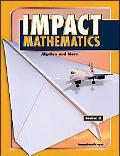

 |

|

The average rating for IMPACT Mathematics:Algebra and More, Course 3 based on 2 reviews is 3 stars.
Review # 1 was written on 2018-07-07 00:00:00 Theresa Kruse Theresa KruseIt is not exactly what you think it is, but it's cool, and interesting and mind blowing. |
Review # 2 was written on 2011-10-30 00:00:00 Venancio Davila Venancio DavilaOverall, Norton presents a decent introduction to the subject, especially for issues that are most relevant to the English Reformation. Beginning with late antiquity and classical notions of "literary"/"literature" in relation to the Bible, he does trace several major themes from their origins up into the Reformation. Unfortunately, because his trajectory does aim, ultimately, for the King James Bible and its influence, there is much lacking from the Middle Ages that could have added to Norton's scope and ideas. Norton is, of course, mainly interested in discussing the Bible "as literature" and issues surrounding these concerns. As such, he sets up several main currents that relate to this larger subject: attitudes toward the Bible as both "textual" (reliant on the form itself) and "a-textual" (reliant on meaning generally) (see esp. p. 3); an "unbreakable connection between the history of ideas of literature and the history of literary ideas of the Bible" (4); translation--especially into English; tensions between aesthetic/literary and theological/spiritual readings; separation from and reconciliation with the Bible and secular learning such as classics (e.g. "sacred" and "profane"); versions of the Bible and the diversity of these traditions; and theories of interpretation. All of these intertwine together throughout the narrative established, and work in a complex manner in this study. All of these notions do deserve attention, and Norton rightly establishes them as key issues for his work. As even he acknowledges, however, all of these ideas taken together create too much for one study to account; in this, his work sometimes veers in one direction, leaving the others behind in the moment. In tracing the development of ideas, the place where Norton's book is most disappointing (from my view, and for my purposes) is in his attention to medieval thinkers. As an early modernist, his focus obviously is on the Reformers; yet he does little service to their predecessors. After providing some adept close readings of key classical writers and early Christian Fathers (notably, Augustine and Jerome), he even claims: "There was no truly fresh thought among the Fathers of the medieval theologians about the eloquence of the Bible after Jerome and Augustine, but that is not to say that ideas did not change" (48). Who these "Fathers" were are not identified, nor how one defines "theologians" (although he is keen to recognize the distinction between literary and theological readings!). As representatives, he offers five pages of discussion on Cassiodorus, Aldhelm, and Bede--skipping over many well-documented discussions of the Bible in both the early medieval and later medieval scholastic periods. This is puzzling, since even some examination of Aelfric's prefaces would yield insights into how medieval thinkers viewed the Bible for its "literary" merits. Indeed, the next chapter attempts to offer another representative mode of medieval thought, as Norton traces the basics of allegory in nine pages. Ultimately, Norton's claims here are that allegory "led to a dead end as far as literary response to the text" (60), and he sets this aside as too explicitly theological of an approach (with which he is, to be fair, not concerned in this book). Yet he also treats allegory as the only mode of reading the Bible in the Middle Ages--a false assumption. In this, he skips over discussions of the Bible from non-allegorical readings, any translations of the Bible into Old or Middle English, and any discussions associated with those phenomena (again, Aelfric's writings would be helpful here). Instead, he quickly moves on to late medieval translators such as (unsurprisingly) Wycliff, Tyndale, and later Reformers. As with many other books on similar subjects, Norton's study no doubt offers insights into the English Reformation and later (modern) conceptions of the "Bible as literature"--but, like other similar books, the bulk of his study really begins too late. As indicated, it is understandable to see this type of work from an early modernist, but, as a book that aims to provide a wide scope from antiquity to modernity, the deficiencies are disappointing. For medievalists, the work of extending such a study from antiquity to the Reformation still has yet to be done. At least Norton has aptly laid the groundwork, and offers a framework within which to set such scholarship in the middle. |
CAN'T FIND WHAT YOU'RE LOOKING FOR? CLICK HERE!!!